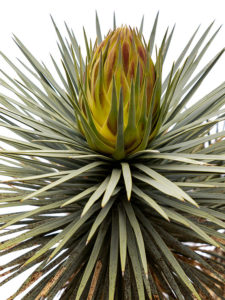I know that this is near impossible to believe, but I may have been wrong when I claimed that the Joshua tree—Yucca brevifolia—was part of the Lily family. Well, it always had been, but modern DNA testing shows enough differences that botanists had to break the giant Lilly family into 40 distinct species. It used to be that scientist categorized plants by looking at their dirty little sex parts, and the flowers of Joshua trees, yuccas, and lilies look the same. Along comes DNA testing and—bam—Joshua Trees are now considered an agave, and its closest cousin is the yucca. DNA is turning our old assumptions upside-down. I always thought that my father’s family came from Poland, but when my DNA tests came back, they said that I’m actually Lower Slobbovian.

My botany lesson is included—at no extra charge—because I was shooting along the Joshua Tree Parkway this week and saw the trees beginning to bloom. Like other agaves, the trees put out a large phallic that opens to an enormous stalk with clusters of white flowers. Research suggests that frost damages the branch ends which triggers the blooms. If a tree doesn’t experience freezing, it doesn’t put out flowers or reproduce. These specimens grow as a single stalk, and the behavior limits the tree’s range to southwest deserts from 2,000 to 6,000 feet of elevation.
Another weird thing about Joshua trees is that they’re pollinated by the Yucca Moth. Polination happens when it lays eggs on the flowers which turn into seed pods resembling a small squash. If you’re a Euell Gibbons follower, you can eat the flowers and fruit. They need to be boiled or roasted to remove bitterness that comes from alkaline soil … and you’ll want to dig the worms out of the fruit. It has a banana taste, or so I’m told. I’ll stick to Mars Bars.
For this week’s featured image, I wanted to show an emerging bud without clutter—almost an abstract graphic. This image worked best for me. I call it Joshua Bud. The flower was overhead and with a cloudy sky. When I processed the photo, I blew-out the highlights to simplify the background. Like the groundhog, the bud says that spring is imminent.
You can see a larger version of Joshua Bud on its Web Page by clicking here. I hope you enjoy viewing this week’s post and come back next week when we’ll begin a series from a new place.
Until next time — jw
